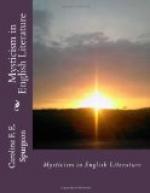Further, in Bergson’s theory of the nature of mind, and in his theory of rhythm, he seems to indicate the lines of a technical explanation of some part of the mystic experience.[84] The soul, or the total psychic and mental life of man, he says, is far greater than the little bit of consciousness of which we are normally aware, and the brain acts as a sheath or screen, which allows only a point of this mental life to touch reality. The brain or the cerebral life is therefore to the whole mental life as the point of a knife is to the knife itself. It limits the field of vision, it cuts in one direction only, it puts blinkers on the mind, forcing it to concentrate on a limited range of facts. It is conceivable that what happens with the mystics is that their mental blinkers become slightly shifted, and they are thus able to respond to another aspect or order of reality. So that they are swept by emotions and invaded by harmonies from which the average man is screened. Life having for them somewhat changed in direction, the brain is forced to learn new movements, to cut along fresh channels, and thus to receive sensations which do not directly minister to the needs of physical life. “Our knowledge of things,” says Bergson, “derives its form from our bodily functions and lower needs. By unmaking that which these needs have made, we may restore to Intuition its original purity, and so recover contact with the Real.” It is possibly this very unmaking and remaking, this readjustment which we see at work in the lives of the great mystics, and which naturally causes great psychic and even physical disturbances.
Bergson’s theory of rhythm is peculiarly illuminating in this connection. The intellect, he says, is like a cinematograph. Moving at a certain pace, it takes certain views, snapshots of the continuous flux of reality, of which it is itself a moving part. The special views that it picks out and registers, depend entirely upon the relation between its movement and the rhythm or movement of other aspects of the flux. It is obvious that there are a variety of rhythms or tensions of duration. For example, in what is the fraction of a second of our own duration, hundreds of millions of vibrations, which it would need thousands of our years to count, are taking place successively in matter, and giving us the sensation of light. It is therefore clear that there is a great difference between the rhythm of our own duration and the incredibly rapid rhythms of physical matter. If an alteration took place in our rhythm, these same physical movements would make us conscious—not of light—but of some other thing quite unknown.
“Would not the whole of history,” asks Bergson, “be contained in a very short time for a consciousness at a higher degree of tension than our own?” A momentary quickening of rhythm might thus account for the sensation of timelessness, of the “participation in Eternity” so often described by the mystic as a part of the Vision of God.




